Evolutionary Overview of Terrace Research Based on Bibliometric Analysis in Web of Science from 1991 to 2020
Abstract
1. Introduction
2. Data Sources and Research Methods
2.1. Data Sources
2.2. Research Methods
3. Summary of Quantitative Research
3.1. Article Publication and Citation Analysis
3.2. Analysis of Authors’ Papers
3.3. Analysis of National Documents
3.3.1. Global Research Analysis
3.3.2. Analysis of Major Research Countries
4. Summary of Qualitative Research
4.1. Analysis of Keyword Co-Occurrence Network
4.2. Analysis of Thematic Evolution
- (1)
- Agriculture (1991–2017);
- (2)
- Soil erosion (1991–2017);
- (3)
- Agricultural landscape (2005–2017);
- (4)
- Land abandonment (2014–2020).
- (1)
- Cultivation terraces (2005–2013) → sustainability (2014–2017);
- (2)
- Ifugao rice terraces (1991–2004) → biodiversity (2005–2013);
- (3)
- Ifugao rice terraces (1991–2013) → ecosystem services (2014–2017);
- (4)
- Soil erosion (1991~2004) → terraces (2005–2013) → runoff (2014–2017);
- (5)
- Soil erosion (1991~2004) → terraces (2005–2017) → terraces landscape (2018–2020);
- (6)
- Terraces (2005~2017) → soil and water conservation (2018–2020).
5. Conclusions and Suggestions
Author Contributions
Funding
Institutional Review Board Statement
Informed Consent Statement
Data Availability Statement
Acknowledgments
Conflicts of Interest
References
- Ni, G. Liang Jiamian’s Collection of Agricultural History; China Agricultural Publishing House: Beijing, China, 2002; pp. 218–236. (In Chinese) [Google Scholar]
- Branch, N.P.; Kemp, R.A.; Silva, B.; Meddens, F.M.; Williams, A.; Kendall, A.; Pomacanchari, C.V. Testing the sustainability and sensitivity to climatic change of terrace agricultural systems in the Peruvian Andes: A pilot study. J. Archaeol. Sci. 2007, 34, 1–9. [Google Scholar] [CrossRef]
- Barker, G.W.; Adams, R.; Creighton, O.H.; Daly, P.; Gilbertson, D.D.; Grattan, J.P.; Hunt, C.O.; Mattingly, D.J.; Mclaren, S.J.; Newson, P.L. Archaeology and Desertification in the Wadi Faynan: The Fourth (1999) Season of the Wadi Faynan Landscape Survey. Levant 2000, 32, 27–52. [Google Scholar] [CrossRef][Green Version]
- Chen, D.; Wei, W.; Chen, L. Historical distribution of terrace landscape and typical international case analysis. Chin. J. Appl. Ecol. 2017, 2, 326–335. (In Chinese) [Google Scholar]
- Mishra, P.K.; Rai, A.; Rai, S.C. Indigenous knowledge of terrace management for soil and water conservation in the Sikkim Himalaya, India. Indian J. Tradit. Knowl. 2020, 19, 475–485. [Google Scholar]
- Xu, Q.X.; Pan, W.; Dai, J.F.; Wan, T.W. The effects of rainfall regimes and terracing on runoff and erosion in the Three Gorges area, China. Environ. Sci. Pollut. Res. 2018, 25, 9474–9484. [Google Scholar] [CrossRef] [PubMed]
- Zhao, X.; Zhu, H.S.; Dong, K.H.; Li, D.Y. Plant Community and Succession in Lowland Grasslands under Saline–Alkali Conditions with Grazing Exclusion. Agron. J. 2017, 109, 2428–2437. [Google Scholar] [CrossRef]
- Gebreslase, M.S.; Oliveira, L.A.A.; Yazew, E.; Bresci, E.; Castelli, G. Spatial Variability of Soil Moisture in Newly Implemented Agricultural Bench Terraces in the Ethiopian Plateau. Water 2019, 11, 2134. [Google Scholar] [CrossRef]
- Londero, A.L.; Minella, J.P.G.; Deuschle, D.; Schneider, F.J.A.; Boeni, M.; Merten, G.H. Impact of broad-based terraces on water and sediment losses in no-till (paired zero-order) catchments in southern Brazil. J. Soils Sediments 2017, 18, 1159–1175. [Google Scholar] [CrossRef]
- Bary, A.A.; Pierzgalski, E. Ridged terraces—Functions, construction and use. J. Environ. Eng. Landsc. Manag. 2008, 16, 1–6. [Google Scholar]
- Xu, G.C.; Zhang, T.G.; Li, Z.B.; Li, P.; Cheng, Y.T.; Cheng, S.D. Temporal and spatial characteristics of soil water content in diverse soil layers on land terraces of the Loess Plateau, China. Catena 2017, 158, 20–29. [Google Scholar] [CrossRef]
- Blecourt, M.; Hansel, V.M.; Brumme, R.; Corre, M.D.; Veldkamp, E. Soil redistribution by terracing alleviates soil organic carbon losses caused by forest conversion to rubber plantation. For. Ecol. Manag. 2014, 313, 26–33. [Google Scholar] [CrossRef]
- Ni, S.J.; Zhang, J.H. Variation of chemical properties as affected by soil erosion on hillslopes and terraces. Eur. J. Soil Sci. 2007, 58, 1285–1292. [Google Scholar] [CrossRef]
- Koyanagi, T.F.; Yamada, S.; Yonezawa, K.I.; Kitagawa, Y.; Ichikawa, K.; Ohlemuller, R. Plant species richness and composition under different disturbance regimes in marginal grasslands of a Japanese terraced paddy field landscape. Appl. Veg. Sci. 2015, 17, 636–644. [Google Scholar] [CrossRef]
- Chen, S.K.; Chen, R.S.; Yang, T.Y. Application of a tank model to assess the flood-control function of a terraced paddy field. Hydrol. Sci. J.-J. Des Sci. Hydrol. 2014, 59, 1020–1031. [Google Scholar] [CrossRef]
- Agnoletti, M.; Conti, L.; Frezza, L.; Santor, A. Territorial Analysis of the Agricultural Terraced Landscapes of Tuscany (Italy): Preliminary Results. Sustainability 2015, 7, 4564–4581. [Google Scholar] [CrossRef]
- Pietsch, D.; Mabit, L. Terrace soils in the Yemen Highlands: Using physical, chemical and radiometric data to assess their suitability for agriculture and their vulnerability to degradation. Geoderma 2012, 185–186, 48–60. [Google Scholar] [CrossRef]
- Xie, H.L.; Chen, Q.R. Land Use and Ecological Civilization: A Collection of Empirical Studies. J. Resour. Ecol. 2021, 12, 137–142. [Google Scholar]
- Lasanta, T.; Arnaez, J.; Ruiz-Flaño, P.; Lana-Renault, N. Agricultural terraces in the Spanish mountains: An abandoned landscape and a potential resource. South Asian Stud. 2013, 63, 487–491. [Google Scholar]
- Caga, K.A.D. Mixed Views on the Philippines’ Ifugao Rice Terraces: ‘Good’ versus ‘Beautiful’ in the Management of a UNESCO World Heritage Site. J. Southeast Asian Stud. 2018, 49, 84–104. [Google Scholar] [CrossRef]
- Fukamachi, K. Sustainability of terraced paddy fields in traditional satoyama landscapes of Japan. J. Environ. Manag. 2016, 202, 543–549. [Google Scholar] [CrossRef]
- Mori, Y.; Sasaki, M.; Morioka, E.; Tsujimoto, K. When do rice terraces become rice terraces? Paddy Water Environ. 2019, 17, 323–330. [Google Scholar] [CrossRef]
- Kladnik, D.; Geršič, M.; Pipan, P.; Bahun, M.V. Land-use changes in Slovenian terraced landscapes. Acta Geogr. Slov. 2019, 59, 119–141. [Google Scholar] [CrossRef]
- Delius, P.; Schirmer, S. Order, openness, and economic change in precolonial southern Africa: A perspective from the bokoni terraces. J. Afr. Hist. 2014, 55, 37–54. [Google Scholar] [CrossRef]
- Bizoza, A.R.; Graaff, J.D. Financial cost–benefit analysis of bench terraces in Rwanda. Land Degrad. Dev. 2012, 23, 103–115. [Google Scholar] [CrossRef]
- Posthumus, H.; Graaff, J.D. Cost-benefit of bench terraces, a case study in Peru. Land Degrad. Dev. 2010, 16, 1–11. [Google Scholar] [CrossRef]
- Pepe, G.; Mandarino, A.; Raso, E.; Scarpellini, P.; Brandolini, P.; Cevasco, A. Investigation on Farmland Abandonment of Terraced Slopes Using Multitemporal Data Sources Comparison and Its Implication on Hydro-Geomorphological Processes. Water 2019, 11, 1552. [Google Scholar] [CrossRef]
- Soriano, M.A.; Herath, S. Quantifying the role of traditional rice terraces in regulating water resources: Implications for management and conservation efforts. Agroecol. Sustain. Food Syst. 2018, 42, 885–910. [Google Scholar] [CrossRef]
- Ubeda, X.; Alcaniz, M.; Borges, G.; Outeiro, L.; Francos, M. Soil Quality of Abandoned Agricultural Terraces Managed with Prescribed Fires and Livestock in the Municipality of Capafonts, Catalonia, Spain (2000–2017). Agronomy 2019, 9, 340. [Google Scholar] [CrossRef]
- Lucas-Borja, M.E.; Calsamiglia, A.; Fortesa, J.; García-Comendador, J.; Guardiola, E.L.; García-Orenes, F.; Gago, J.; Estrany, J. The role of wildfire on soil quality in abandoned terraces of three Mediterranean micro-catchments. Catena 2018, 170, 256. [Google Scholar] [CrossRef]
- Brandolini, P.; Cevasco, A.; Capolongo, D.; Pepe, G.; Lovergine, F.; Del Monte, M. Response of Terraced Slopes to a Very Intense Rainfall Event and Relationships with Land Abandonment: A Case Study from Cinque Terre (Italy). Land Degrad. Dev. 2018, 29, 630–642. [Google Scholar] [CrossRef]
- Chen, X.L.; Zou, D.; Kohnke, L.; Xie, H.R.; Cheng, G. Affective states in digital game-based learning: Thematic evolution and social network analysis. PLoS ONE 2021, 16, e0255184. [Google Scholar] [CrossRef] [PubMed]
- Li, H.; Pan, Y.G.; Wang, L. Biblimetrix: Introduction and evaluation of a new bibliometrics software based on R language. J. Librariansh. Inf. Sci. 2018, 36, 93–104. [Google Scholar]
- Xie, H.L.; Zhang, Y.W.; Choi, Y.R.; Li, F.Q. A Scientometrics Review on Land Ecosystem Service Research. Sustainability 2020, 12, 2959. [Google Scholar] [CrossRef]
- Huang, Y.Q.; Li, F.Q.; Xie, H.L.A. Scientometrics Review on Farmland Abandonment Research. Land 2020, 9, 263. [Google Scholar] [CrossRef]
- Xie, H.L.; Zhang, Y.W.; Zeng, X.J.; He, Y.F. Sustainable land use and management research: A scientometric review. Landsc. Ecol. 2020, 35, 2381–2411. [Google Scholar] [CrossRef]
- Zong, Q.; Yuan, Q.; Shen, H. Analysis of hot spots of library science research in China in 2010 based on VOSviewer. Library 2012, 4, 88–90. (In Chinese) [Google Scholar]
- Li, J.; Hale, A. Output distributions and topic maps of safety related journals. Saf. Sci. 2016, 82, 236–244. [Google Scholar] [CrossRef]
- Jeong, D.; Koo, Y. Analysis of Trend and Convergence for Science and Technology using the VOSviewer. Int. J. Contents 2016, 12, 54–58. [Google Scholar] [CrossRef]
- Lu, X.; Peng, W.L.; Huang, X.J.; Fu, Q.Q.; Zhang, Q.J. Homestead management in China from the “separation of two rights” to the “separation of three rights”: Visualization and analysis of hot topics and trends by mapping knowledge domains of academic papers in China National Knowledge Infrastructure (CNKI). Land Use Policy 2020, 97, 104670. [Google Scholar] [CrossRef]
- Xie, H.L.; Wen, Y.Y.; Choi, Y.R.; Zhang, X.M. Global Trends on Food Security Research: A Bibliometric Analysis. Land 2021, 10, 119. [Google Scholar] [CrossRef]
- Gallart, F.; Llorens, P.; Latron, J. Studying the role of old agricultural terraces on runoff generation in a small Mediterranean mountainous basin. J. Hydrol. 1994, 159, 291–303. [Google Scholar] [CrossRef]
- Dunjo, G.; Pardini, G.; Gispert, M. Land use change effects on abandoned terraced soils in a Mediterranean catchment, NE Spain. Catena 2003, 52, 23–37. [Google Scholar] [CrossRef]
- Koulouri, M.; Giourga, C. Land abandonment and slope gradient as key factors of soil erosion in Mediterranean terraced lands. Catena 2007, 69, 274–281. [Google Scholar] [CrossRef]
- Zhao, H.Q.; Fang, X.; Ding, H.; Strobl, J. Extraction of Terraces on the Loess Plateau from High-Resolution DEMs and Imagery Utilizing Object-Based Image Analysis. ISPRS Int. J. Geo-Inf. 2017, 6, 157. [Google Scholar] [CrossRef]
- Liu, M.C.; Xiong, Y.; Zheng, Y.; Min, Q.W.; Sun, Y.H.; Fuller, A.M. Standards of ecological compensation for traditional eco-agriculture: Taking rice-fish system in Hani terrace as an example. J. Mt. Sci. 2014, 11, 1049–1059. [Google Scholar] [CrossRef]
- He, Y.; Zhan, F.; Zu, Y.; Liu, C.; Yuan, L. Effect of Elevated UV-B Radiation on the Antioxidant System of Two Rice Landraces in Paddy Fields on Yuanyang Terrace. Int. J. Agric. Biol. 2014, 16, 585–590. [Google Scholar]
- Li, X.; He, Y.M.; Xie, C.M.; Zu, Y.Q.; Zhan, F.D.; Mei, X.Y.; Xia, Y.; Li, Y. Correction: Effects of UV-B radiation on the infectivity of Magnaporthe oryzae and rice disease-resistant physiology in Yuanyang terraces. Photochem. Photobiol. Sci. 2017, 17, 7393. [Google Scholar] [CrossRef]
- Li, Y.; Lindstrom, M.J. Evaluating Soil Quality–Soil Redistribution Relationship on Terraces and Steep Hillslope. Soil Sci. Soc. Am. J. 2001, 65, 1500–1508. [Google Scholar] [CrossRef]
- Yang, H.; Shao, X.X.; Wu, M.A. Review on Ecosystem Health Research: A Visualization Based on CiteSpace. Sustainability 2019, 11, 4908. [Google Scholar] [CrossRef]
- Ran, Q.H.; Chen, X.X.; Hong, Y.Y.; Ye, S.; Gao, J.H. Impacts of terracing on hydrological processes: A case study from the Loess Plateau of China. J. Hydrol. 2020, 588, 125045. [Google Scholar] [CrossRef]
- Xu, G.C.; Ren, Z.P.; Li, P.; Li, Z.B.; Yuan, S.L.; Zhang, H.; Wang, D.; Zhang, Z.Y. Temporal persistence and stability of soil water storage after rainfall on terrace land. Environ. Earth Sci. 2016, 75, 966. [Google Scholar] [CrossRef]
- Shi, Y.Z.; Wang, Y.H.; Cui, Y.L.; Wang, S.W.; Zhang, Y.S. A new rainwater harvesting and recycling system for transforming sloping land into terraced farmland. J. Mt. Sci. 2014, 11, 205–214. [Google Scholar] [CrossRef]
- Pipan, P.; Kokalj, Z. Transformation of the Jeruzalem Hills cultural landscape with modern vineyard terraces. Acta Geogr. Slov. 2017, 57, 149–162. [Google Scholar] [CrossRef][Green Version]
- Zhou, X.; Zhang, C. The relationship evolution and interactive mechanism between heritage and tourism of Hani Terrace in Yuanyang. Hum. Geogr. 2019, 34, 154–160. (In Chinese) [Google Scholar]
- Zhang, A. Evolution and differentiation of agricultural land use behavior of different types of farmers in Agricultural Cultural Heritage Tourism Destination: A case study of Hani Terrace. Tour. Sci. 2020, 35, 51–63. (In Chinese) [Google Scholar]
- Feng, Z. The mutual benefit and symbiosis of terrace sightseeing, rice farming and national culture. J. Hubei Minzu Univ. (Philos. Soc. Sci.) 2020, 38, 96–103. (In Chinese) [Google Scholar]
- Miao, J.Q.; Wang, Z.Q.; Yang, W.T.; Sun, S.; Huang, G.Q. Ecosystem service function and value evaluation of Chongyi Hakka terrace area. J. Nat. Resour. 2016, 31, 1817–1831. (In Chinese) [Google Scholar]
- Chen, Y. The cultural beauty of Hani’s terrace Tourism. Heilongjiang Natl. Ser. 2008, 2, 154–158. (In Chinese) [Google Scholar]
- Beach, T.; Luzzadder-Beach, S.; Terry, R.; Dunning, N.; Houston, S.; Garrison, T. Carbon isotopic ratios of wetland and terrace soil sequences in the Maya Lowlands of Belize and Guatemala. Catena 2011, 85, 109–118. [Google Scholar] [CrossRef]
- Borisov, A.V.; Chernysheva, E.V.; Korobov, D.S. Buried Paleoanthrosols of the Bronze Age agricultural terraces in the Kislovodsk basin (Northern Caucasus, Russia). Quat. Int. 2015, 418, 28–36. [Google Scholar] [CrossRef]
- Ferro-Vazquez, C.; Lang, C.; Kaal, J.; Stump, D. When is a terrace not a terrace? The importance of understanding landscape evolution in studies of terraced agriculture. J. Environ. Manag. 2017, 202, 500–513. [Google Scholar] [CrossRef] [PubMed]
- Jiang, Y.G.; Li, S.J.; Cai, D.S.; Chen, W.; Liu, Y.; Yu, Z. The genesis and paleoenvironmental records of Longji agricultural terraces, southern China: A pilot study of human–environment interaction. Quat. Int. 2014, 321, 12–21. [Google Scholar] [CrossRef]
- Lansing, J.S.; Thurner, S.; Ning, N.C.; Coudurier-Curveur, A.; Chew, L.Y. Adaptive self-organization of Bali’s ancient rice terraces. Proc. Natl. Acad. Sci. USA 2017, 114, 6504–6509. [Google Scholar] [CrossRef]
- Jiao, Y.M.; Li, X.Z.; Liang, L.H.; Takeuchi, K.; Okuro, T.; Zhang, D.D.; Sun, L.F. Indigenous Ecological Knowledge and Natural Resource Management in the Cultural Landscape of China’s Hani Terraces. Ecol. Res. 2011, 27, 247–263. [Google Scholar] [CrossRef]
- Chen, Q.R.; Xie, H.L. Research Progress and Discoveries Related to Cultivated Land Abandonment. J. Resour. Ecol. 2021, 12, 165–174. [Google Scholar]
- Hribar, M.M.; Geri, M.; Pipan, P.; Repolusk, P.; Cigli, R. Cultivated terraces in Slovenian landscapes. Acta Geogr. Slov. 2017, 57, 83–97. [Google Scholar]
- Chen, B.; Qiu, Z.; Nakamura, K. Tourist preferences for agricultural landscapes: A case study of terraced paddy fields in Noto Peninsula, Japan. J. Mt. Sci. 2016, 13, 1880–1892. [Google Scholar] [CrossRef]
- Kizos, T.; Koulouri, M.; Vakoufaris, H.; Psarrou, M. Preserving Characteristics of the Agricultural Landscape through Agri-Environmental Policies: The Case of Cultivation Terraces in Greece. Landsc. Res. 2010, 35, 577–593. [Google Scholar] [CrossRef]
- Zhang, J.H.; Su, Z.A.; Liu, G.C. Effects of terracing and agroforestry on soil and water loss in hilly areas of the Sichuan Basin, China. J. Mt. Sci. 2008, 5, 241–248. [Google Scholar] [CrossRef]
- Chen, D.; Wei, W.; Chen, L.D. Effects of terracing practices on water erosion control in China: A meta-analysis. Earth-Sci. Rev. 2017, 173, 109–121. [Google Scholar] [CrossRef]
- Liu, S.L.; Dong, Y.H.; Li, D.; Liu, Q.; Wang, J.; Zhang, X.L. Effects of different terrace protection measures in a sloping land consolidation project targeting soil erosion at the slope scale. Ecol. Eng. 2013, 53, 46–53. [Google Scholar] [CrossRef]
- Chen, S.; Chen, Y.; Peng, Y. Experimental study on soil erosion characteristics in flooded terraced paddy fields. Paddy Water Environ. 2013, 11, 433–444. [Google Scholar] [CrossRef]
- Lesschen, J.P.; Cammeraat, L.H.; Nieman, T. Erosion and terrace failure due to agricultural land abandonment in a semi-arid environment. Earth Surf. Process. Landf. 2010, 33, 1574–1584. [Google Scholar] [CrossRef]
- Boselli, V.; Ouallali, A.; Briak, H.; Houssni, M.; Kassout, J.; El Ouahrani, A.; Michailidi, E.M. System Dynamics Applied to Terraced Agroecosystems: The Case Study of Assaragh (Anti Atlas Mountains, Morocco) (Special Issue: Terraced Landscapes and Hydrological-Geological Hazards). Water 2020, 12, 1693. [Google Scholar] [CrossRef]
- Paliaga, G.; Luino, F.; Turconi, L.; Graff, J.V.D.; Faccini, F. Terraced Landscapes on Portofino Promontory (Italy): Identification, Geo-Hydrological Hazard and Management. Water 2020, 12, 435. [Google Scholar] [CrossRef]
- José, R.A.; Marisa, T.; Concepción, J.; Jorge, A.R.B.; Francisco, J.D. Plant species composition and richness in abandoned agricultural terraces vs. natural soils on Lanzarote (Canary Islands). J. Arid. Environ. 2016, 124, 165–171. [Google Scholar]
- Arévalo, J.R.; Fernández-Lugo, S.; Reyes-Betancort, J.A.; Tejedor, M.; Jiménez, C.; Díaz, F.J. Relationships between soil parameters and vegetation in abandoned terrace fields vs. non-terraced fields in arid lands (Lanzarote, Spain): An opportunity for restoration. Acta Oecologica 2017, 85, 77–84. [Google Scholar] [CrossRef]
- Bantayan, N.C.; Calderon, M.M.; Dizon, J.T.; Sajise, A.J.U.; Salvador, M. Estimating the Extent and Damage of the UNESCO World Heritage Sites of the Ifugao Rice Terraces, Philippines. J. Environ. Manag. 2012, 15, 1–5. [Google Scholar]
- Joshi, R.C.; Matchoc, O.R.O.; Bahatan, R.G.; Pena, F.A.D. Farmers’ knowledge, attitudes and practices of rice crop and pest management at Ifugao Rice Terraces, Philippines. Pans Pest Artic. News Summ. 2000, 46, 43–48. [Google Scholar] [CrossRef]
- Joshi, R.C.; Delacruz, M.S.; Martin, E.C.; Cabigat, J.C.; Bahatan, R.G.; Bahatan, A.D.; Abayao, E.H.; Choy-Awon, J.; Chilagan, N.P.; Cayong, A.B. Current Status of the Golden Apple Snail in the Ifugao Rice Terraces, Philippines. J. Sustain. Agric. 2001, 18, 71–90. [Google Scholar] [CrossRef]
- Pascal, A.; Laurence, B.; Pierre, G.; Frédéric, M.; Hervé, S.; Romain, F.; Denis, F.; Eric, D.; Frédérique, C.; Jin, B.H.; et al. Heterogeneity of the rice microbial community of the Chinese centuries-old Honghe Hani rice terraces system. Environ. Microbiol. 2020, 22, 3429–3445. [Google Scholar] [CrossRef]
- Yang, L.; Liu, M.C.; Lun, F.; Min, Q.W.; Zhang, C.Q.; Li, H.Y. Livelihood Assets and Strategies among Rural Households: Comparative Analysis of Rice and Dryland Terrace Systems in China. Sustainability 2018, 10, 2525. [Google Scholar] [CrossRef]
- Dizon, J.T.; Calderon, M.M.; Sajise, A.J.U.; Andrada, R.T.; Salvador, M.G. Youths’ Perceptions of and Attitudes towards the Ifugao Rice Terraces. J. Environ. Manag. 2012, 15, 52–58. [Google Scholar]
- Liu, M.C.; Liu, W.W.; Yang, L.; Jiao, W.J.; He, S.Y.; Min, Q.W. A dynamic eco-compensation standard for Hani Rice Terraces System in southwest China. Ecosyst. Serv. 2019, 36, 100897. [Google Scholar] [CrossRef]
- Gu, H.; Jiao, Y.; Liang, L. Strengthening the socio-ecological resilience of forest-dependent communities: The case of the Hani Rice Terraces in Yunnan, China. For. Policy Econ. 2012, 22, 53–59. [Google Scholar] [CrossRef]
- Benz, U.C.; Hofmann, P.; Willhauck, G.; Lingenfelder, I.; Heynen, M. Multi-resolution, object-oriented fuzzy analysis of remote sensing data for GIS-ready information. ISPRS J. Photogramm. Remote Sens. 2004, 58, 239–258. [Google Scholar] [CrossRef]
- Wang, Y.N.; Sun, H.J. On the importance of environmental protection and sustainable development from the collapse of terrace. City Geogr. 2017, 10, 189–190. (In Chinese) [Google Scholar]
- Miao, J.Q. Ecosystem Services of Chongyi Hakka Rice Terrace and Its Sustainable Management in Jiangxi Province. Ph.D. Thesis, Jiangxi Agricultural University, Nanchang, China, 2012. [Google Scholar]
- Jiang, Z.S.; Chen, H.L.; Jiang, G.Z. Combinative Practice of Sustainable Protection of World Cultural Heritage and Targeted Poverty Alleviation: A Case Study of “Rice-fish Culture” Mode in Hani Terraced Fields of Honghe, Yunnan. Chin. Agric. Sci. Bull. 2018, 34, 160–164. [Google Scholar]
- Miao, J.Q.; Wang, Z.Q.; Ma, Y.Q.; Yang, W.T.; Yang, B.J. Comprehensive evaluation of sustainable development of the Hakka Terrace Ecosystem of Chongyi. Acta Ecol. Sin. 2018, 38, 6326–6336. [Google Scholar]
- Ni, H. The concept and path of sustainable development of Hani Terrace Agriculture from the perspective of ecological civilization. World Agric. 2014, 11, 156–159. (In Chinese) [Google Scholar]
- Agus, F.; Irawan, I.; Suganda, H.; Wahyunto, W.; Setiyanto, A.; Kundarto, M. Environmental multi-functionality of Indonesian agriculture. Paddy Water Environ. 2006, 4, 181–188. [Google Scholar] [CrossRef]
- Gan, D.X.; Long, Y.L.; Huang, H.; Xiong, X.Y. The disaster prevention mechanism and benefit analysis of the mountain terraced field landscape—taking the Ziquejie terraced field as an example. J. Nat. Disasters 2006, 15, 106–108. (In Chinese) [Google Scholar]
- Bulilan, C.M.R. Experiencing cultural heritage and indigenous tourism in Banaue. Philipp. Q. Cult. Soc. 2007, 35, 100–128. [Google Scholar]
- Li, Z.M.; Zou, H.X.; Yi, Q.Q.; Zhou, Q. Research on the evaluation of tourist resources potential of terraced agricultural cultural heritage. Econ. Geogr. 2015, 35, 198–208. (In Chinese) [Google Scholar]
- Jiao, Y.M.; Yang, Y.J.; Hu, W.Y.; Su, S.H. Analysis of spatial pattern and aesthetic features of Hani Terraced Fields. Geogr. Res. 2006, 25, 624–632. (in Chinese). [Google Scholar]
- Drechsler, M.; Settele, J. Predator-prey interactions in rice ecosystems: Effects of guild composition, trophic relationships, and land use changes—A model study exemplified for Philippine rice terraces. Ecol. Model. 2001, 137, 135–159. [Google Scholar] [CrossRef]
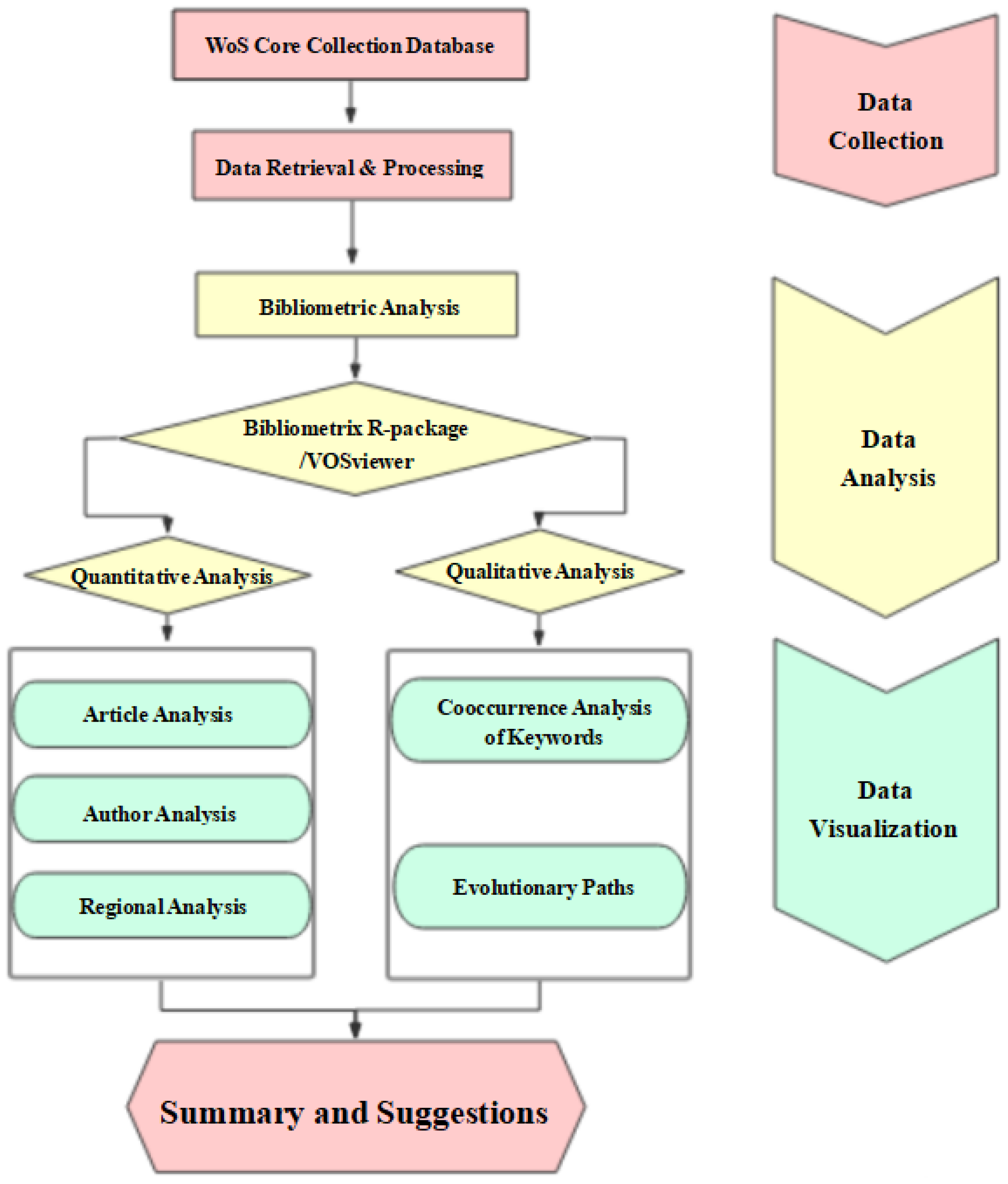

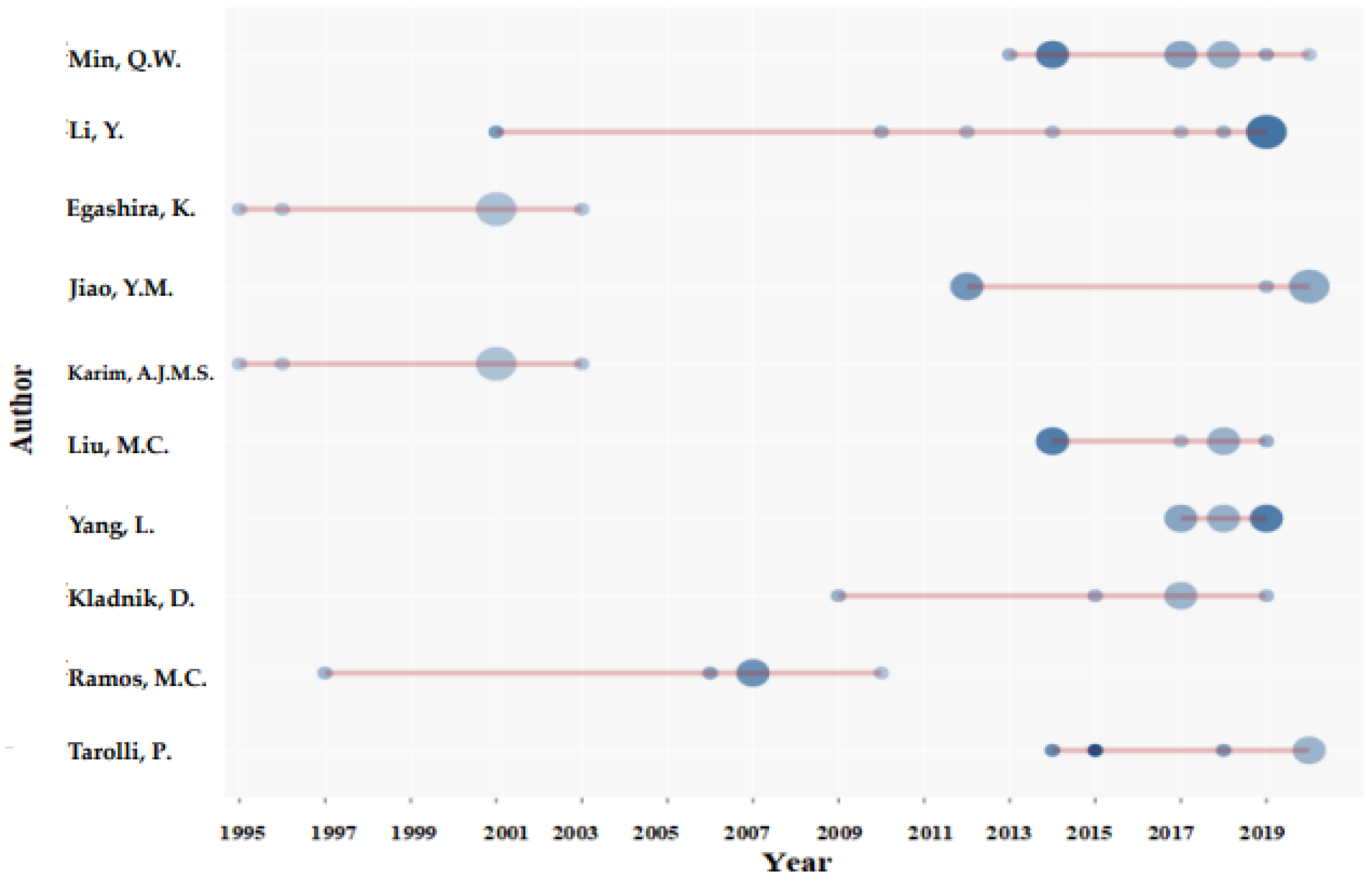

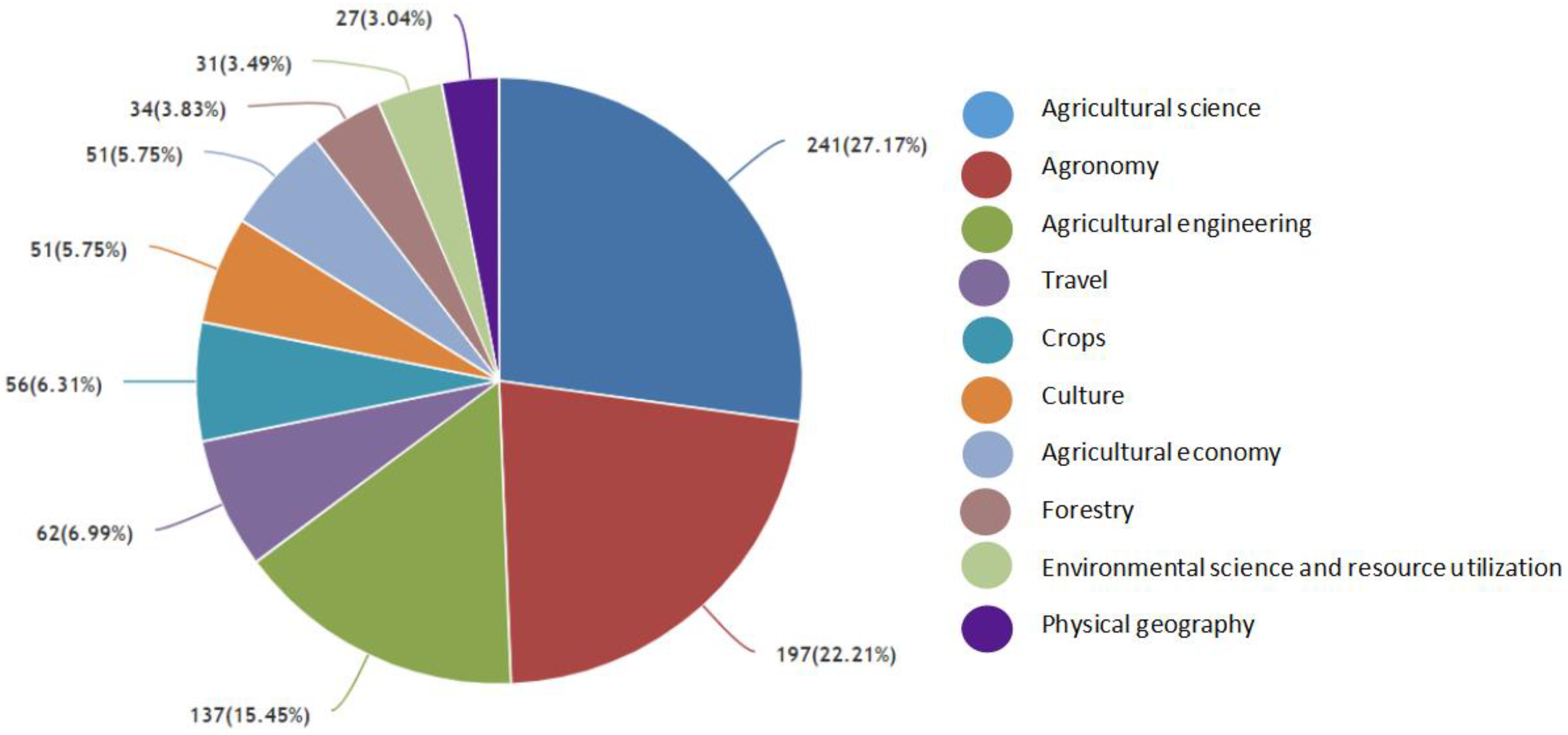
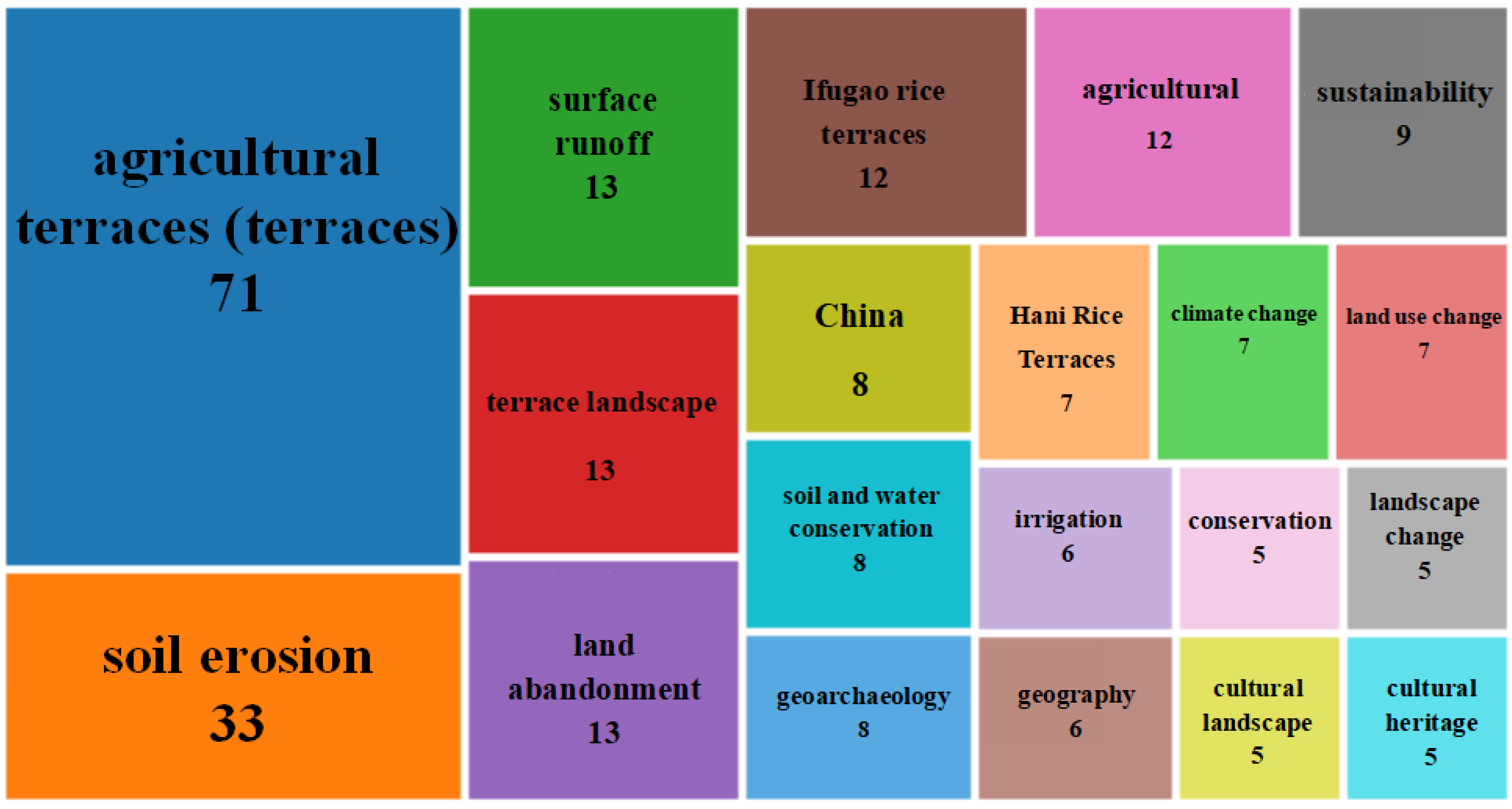
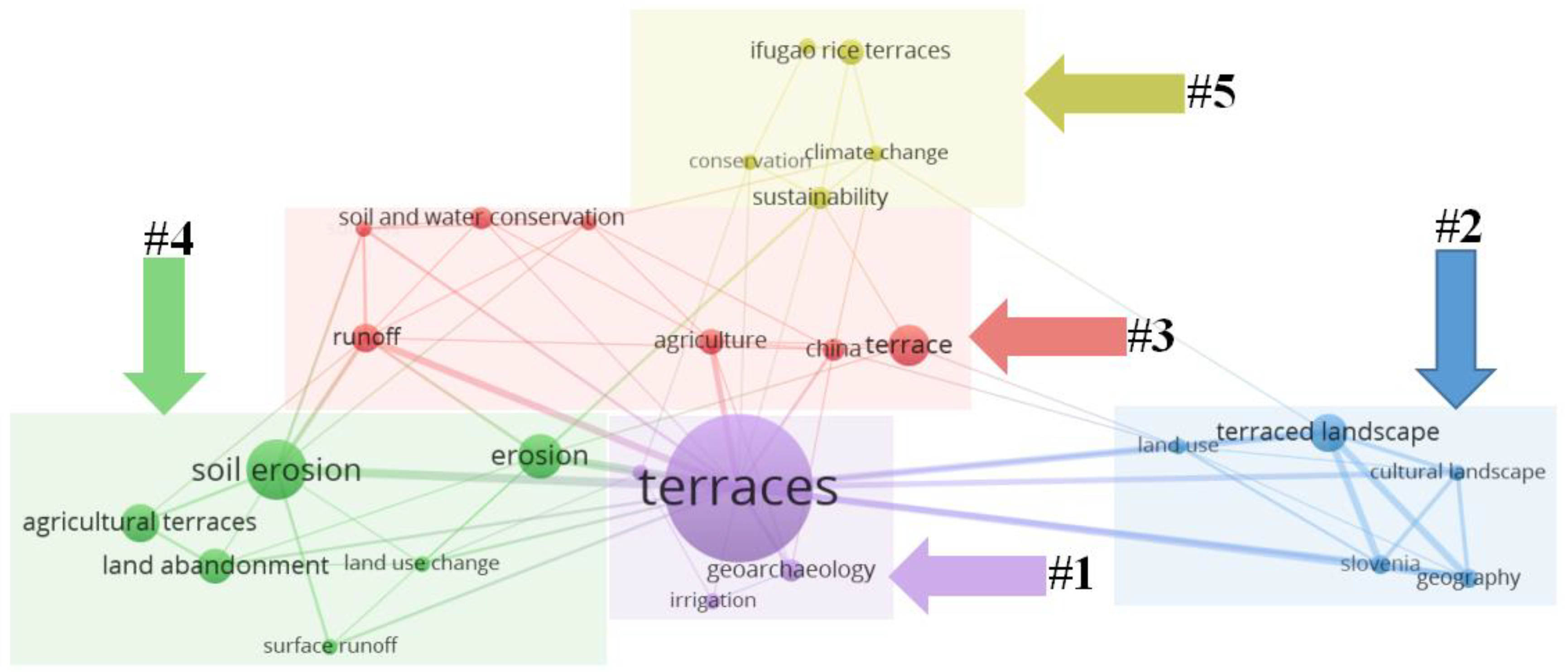

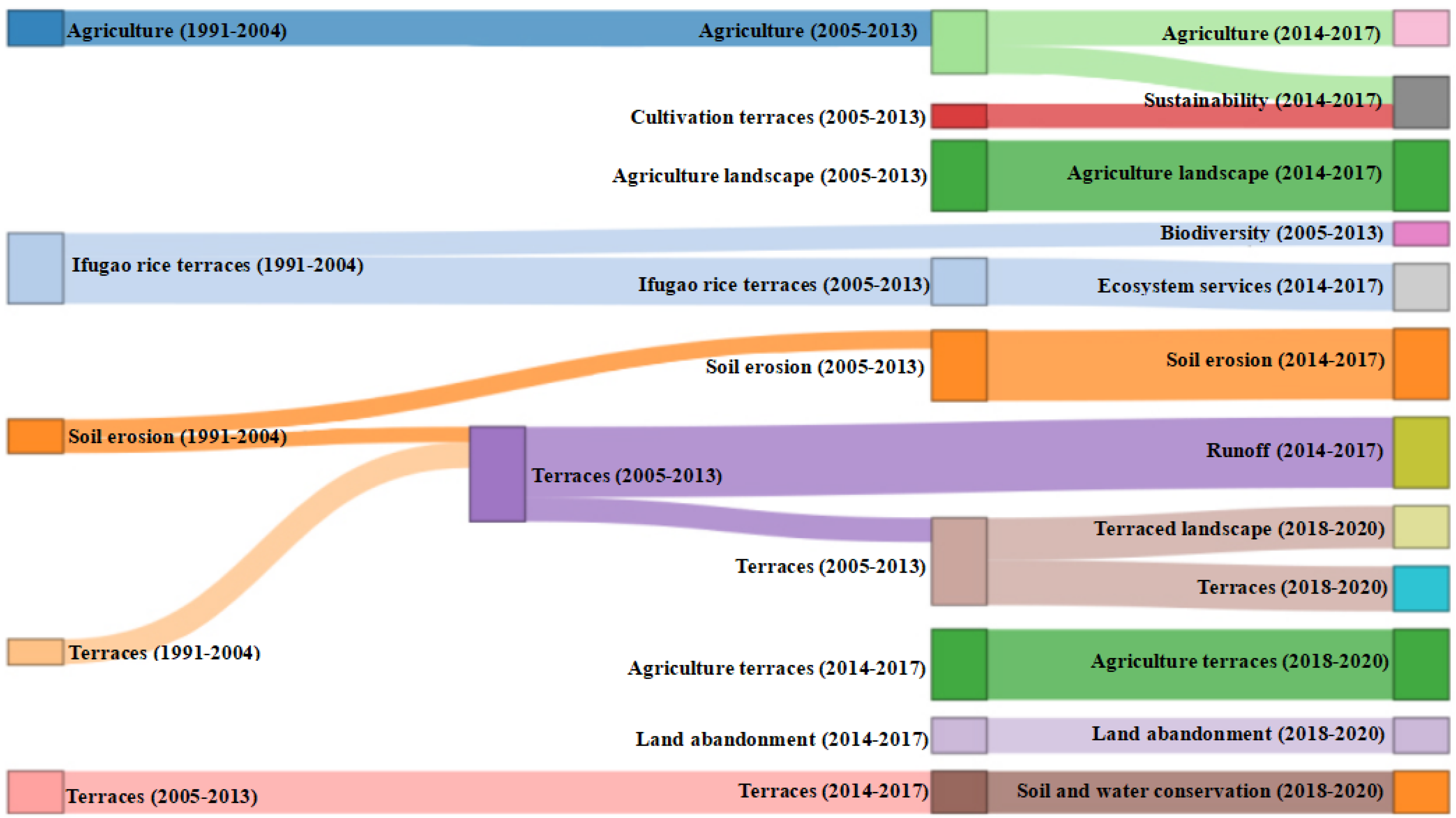
| Author | H_Index | TC | NP | PY_Start |
|---|---|---|---|---|
| Min Q.W. | 5 | 96 | 9 | 2013 |
| Li Y. | 5 | 121 | 7 | 2001 |
| Egashira K. | 3 | 20 | 6 | 1995 |
| Jiao Y.M. | 4 | 53 | 6 | 2012 |
| Karim A.J.M.S. | 3 | 20 | 6 | 1995 |
| Liu M.C. | 4 | 69 | 6 | 2014 |
| Yang L. | 4 | 41 | 6 | 2017 |
| Kladnik D. | 4 | 49 | 5 | 2009 |
| Ramos M.C. | 4 | 159 | 5 | 1997 |
| Tarolli P. | 3 | 137 | 5 | 2014 |
| Region | Articles | Total Citations | Average Number of Article Citations |
|---|---|---|---|
| China | 203 | 732 | 3.61 |
| USA | 95 | 784 | 8.25 |
| Japan | 62 | 224 | 3.61 |
| Spain | 60 | 1136 | 18.93 |
| Italy | 38 | 401 | 10.55 |
| United Kingdom | 35 | 510 | 14.57 |
| India | 30 | 40 | 1.33 |
| Germany | 28 | 234 | 8.36 |
| Philippines | 26 | 85 | 3.27 |
| France | 18 | 74 | 4.11 |
| Name | Location | Area (hm) | Crop | World Heritage Site |
|---|---|---|---|---|
| Honghe Hani Terraced Fields | Yunnan | 16,603 | Rice | UNESCO(2013), GIAHS(2010) |
| Longji Terrace | Guangxi | 7010 | Rice | GIAHS(2018) |
| Ziquejie Terrace | Hunan | 1334 | Rice | GIAHS(2018) |
| Chongyi Hakka Terraces | Jiangxi | 2000 | Rice | GIAHS(2018) |
| Youxi United Terrace | Fujian | 713 | Rice | GIAHS(2018) |
Publisher’s Note: MDPI stays neutral with regard to jurisdictional claims in published maps and institutional affiliations. |
© 2022 by the authors. Licensee MDPI, Basel, Switzerland. This article is an open access article distributed under the terms and conditions of the Creative Commons Attribution (CC BY) license (https://creativecommons.org/licenses/by/4.0/).
Share and Cite
Chen, Q.; Wen, Y.; Zhang, X.; Zhu, Z. Evolutionary Overview of Terrace Research Based on Bibliometric Analysis in Web of Science from 1991 to 2020. Int. J. Environ. Res. Public Health 2022, 19, 7796. https://doi.org/10.3390/ijerph19137796
Chen Q, Wen Y, Zhang X, Zhu Z. Evolutionary Overview of Terrace Research Based on Bibliometric Analysis in Web of Science from 1991 to 2020. International Journal of Environmental Research and Public Health. 2022; 19(13):7796. https://doi.org/10.3390/ijerph19137796
Chicago/Turabian StyleChen, Qianru, Yuyang Wen, Xinmin Zhang, and Zhenhong Zhu. 2022. "Evolutionary Overview of Terrace Research Based on Bibliometric Analysis in Web of Science from 1991 to 2020" International Journal of Environmental Research and Public Health 19, no. 13: 7796. https://doi.org/10.3390/ijerph19137796
APA StyleChen, Q., Wen, Y., Zhang, X., & Zhu, Z. (2022). Evolutionary Overview of Terrace Research Based on Bibliometric Analysis in Web of Science from 1991 to 2020. International Journal of Environmental Research and Public Health, 19(13), 7796. https://doi.org/10.3390/ijerph19137796





